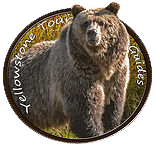How Did Yellowstone Get Its Name?
Established in 1872, Yellowstone National Park was the world’s first national park. However, its history stretches back much farther than 1872. We must step into this history to discover how this park was named.
Taking in the large yellow cliffs, it might seem like a straightforward story. Yet, this name was the result of a combination of languages and groups of people who helped give the park its modern nomenclature. Here’s how it happened:
- The river: The major river that runs through Yellowstone National Park is Yellowstone River. The park is named for this body of water. But how did the river get its name?
- The Minnetaree tribe: In the 1800s, French-Canadian trappers traveled to the area. They encountered the Minnetaree Tribe, who lived in modern Montana. When the trappers asked these Native Americans the name of the river, they responded “Mi tse a-da-zi.” This translates literally as “Rock Yellow River.”
- French translation: The trappers took this meaning and translated it to French as “Pierre Jaune” or “Roche Jaune.”
- English translation: In 1797, along came David Thompson, an explorer and geographer. He began using the English version, “Yellow Stone.”
- Lewis and Clark: These two explorers used both the French and English forms of the name to refer to the Yellowstone River. Eventually, common use solidified the name as Yellowstone.
Other fun facts about Yellowstone National Park
What kind of wildlife can I see at Yellowstone National Park?
Yellowstone National Park offers a diverse landscape that supports an immense variety of wildlife. You can find nearly 300 species of birds in the park! Exploring the waters will reveal 16 different types of fish and five species of amphibians. As you trek around the park, you can also encounter six species of reptiles and another 67 species of mammals. This includes two bear species—watch out!
What kind of landscape will I see at Yellowstone National Park?
You’ll probably find that exploring Yellowstone National Park feels like traveling to another planet. In each section of the park, you’ll encounter incredible land formations that are immensely different than the previous ones. With so many unique features, the park is truly a natural wonder.
Throughout the park, you’ll discover geysers, steam vents, mudpots, hot springs, the Yellowstone River Grand Canyon, mountains, plateaus and more.
What kind of plants grow in Yellowstone National Park?
The flora of Yellowstone National Park is just as diverse as the landscape and other living creatures. A trip through the park will reveal hundreds of wildflowers. You’ll also see many species of shrubs, including Rocky Mountain maple and sagebrush. Nine different conifer trees also grow in the park, as well as a few deciduous species. Yellowstone also features three plant species that are found only in the park: Yellowstone sulfur wild buckwheat, Ross’s bentgrass and Yellowstone sand verbena.
Learn more about the park
For more information on Yellowstone National Park or to plan your next visit, contact Yellowstone Tour Guides. Since 2001, we have been dedicated to showing families the beauty of Yellowstone Nation Park. We offer small-group sightseeing tours, multi-day backpacking experiences and hiking tours. We look forward to exploring Yellowstone with you!
